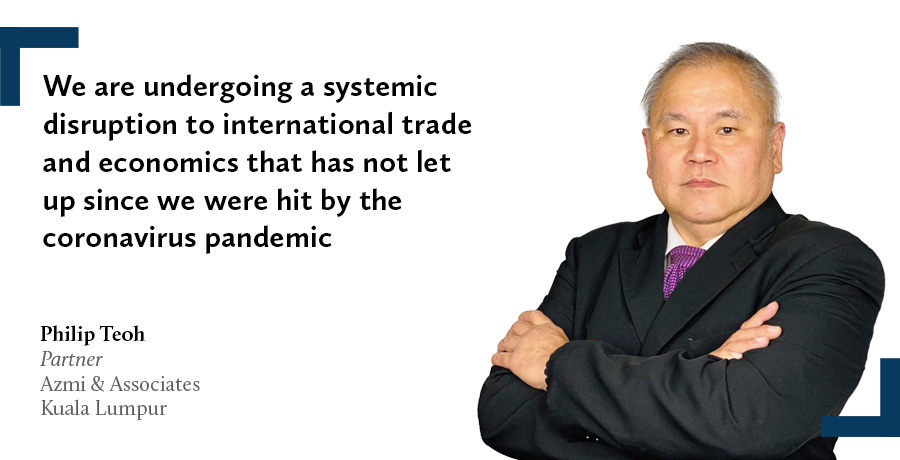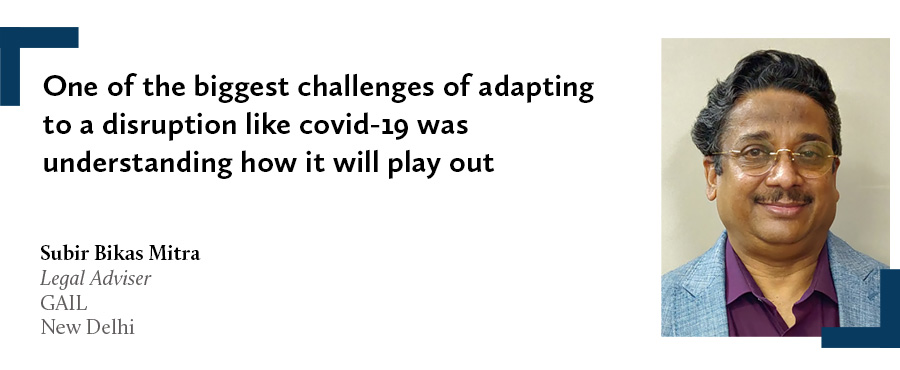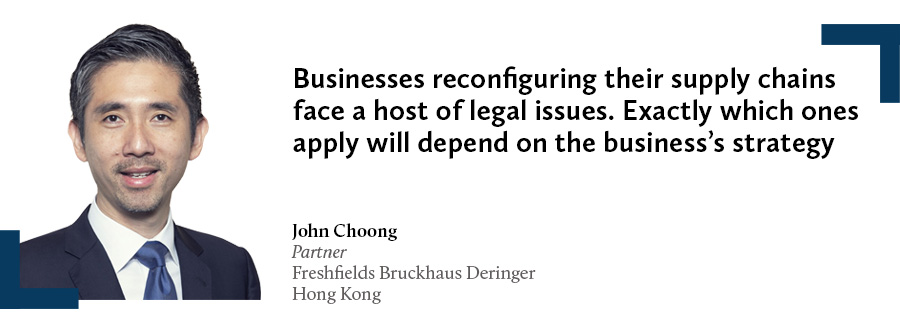The world’s economies are facing one of their most difficult periods since the global financial crisis, and Asia is unlikely to escape the consequences. George W Russell asks legal experts how clients can mitigate the damage from global headwinds impacting their operations
Asia faces not only a cryptocurrency winter, but also the chill of an economic slowdown accelerated by Russia’s war on Ukraine, lingering covid-19 lockdowns in China, and spiralling inflation across much of the world.
US corporations in China have cut their revenue projections, according to the American Chamber of Commerce, while many European companies plan to downsize operations. That sentiment is echoed in a wider global “misery index” says Keith Wade, chief economist and chief strategist at Schroders in London.
“The ‘misery index’, an economic indicator that helps determine how the average citizen is doing economically, is now in the highest 20% of readings across almost 50 years,” says Wade. “We’re effectively at the early stages of an economic slowdown.”
Asia is also facing economic headwinds. In the second quarter of 2022, China’s economy grew at the slowest pace since the start of the pandemic. The world’s second-largest economy expanded just 0.4% year on year between April and June, official data showed.
The new economy has been particularly vulnerable. Singapore-based Sea Group’s e-commerce arm, Shopee, shut its India operations in March and laid off staff in Indonesia, Thailand and Vietnam. The Chinese ride-hailing platform, Caocao Chuxing, has dramatically reduced its headcount by up to 40%, while internet giants such as Alibaba have shed employees, according to official media.
Crypto platforms have been devastated by the slump in the value of digital assets. The Singapore-based crypto hedge fund, Three Arrows Capital, declared bankruptcy, while China’s Huobi Global is weighing layoffs.
“We are undergoing a systemic disruption to international trade and economics that has not let up since we were hit by the coronavirus pandemic,” says Philip Teoh, partner and head of the admiralty and shipping, insurance and international trade practice group at Malaysian law firm Azmi & Associates in Kuala Lumpur.
Even Asia’s much-vaunted manufacturing activity has stalled. June data showed many companies were hit by supply disruptions caused by China’s strict covid-19 lockdowns, while sharp economic slowdown risks in Europe and North America have stoked fears of a wider recession.
China’s factory activity is rebounding, though, as restrictions mostly ease and companies adapt to “closed-loop” working to limit the spread of coronavirus. But output in Japan, South Korea and Taiwan has been crimped by supply disruptions, rising costs, and raw material and component shortages.
For some lawyers, the situation has obviously become untenable. “Clearly lockdowns have deeply impacted the Chinese economy and have damaged economic development,” says Cheng Tai-Heng, global co-head of arbitration and trade, and co-managing partner at Sidley Austin in Singapore. “My instinct is they know this and it’s not positive or sustainable. China will reverse course.”
Looming global recession
As the world’s largest economy, the US is the focus of interest. A recession is indicated by two consecutive quarters of declines in GDP, which is increasingly likely, according to most pundits. “We think that growth worries will gain traction with the monetary authorities,” says Eugene Leow, senior rates strategist at DBS in Singapore.
“In any case, we are somewhat concerned that financial conditions have been moderately stressed for some time. Weak financial conditions tend to foreshadow a slowdown in US economic activity by several months.”
Any US recession would have global repercussions. Economist Chetan Seth and his team at Nomura in Singapore say it is likely to begin in the fourth quarter of 2022, with a risk that it could start even sooner. “Consequently, much of the developed world – the euro area, the UK and Canada – are also likely to see a recession in the next 12 months,” Seth forecasts.
The Asia-Pacific region would not be immune, with Japan, South Korea and Australia affected soon after, he adds. “Australia’s consumer confidence has fallen to levels only seen a handful of times in the past three decades, consistent with a stagnation in consumer spending,” says Marcel Thieliant, Australia and New Zealand economist at Capital Economics in Singapore. “In New Zealand, confidence has fallen to a record low.”
India – the world’s sixth-largest economy, with one of the highest GDP growth rates in the world – has seen its economic expansion forecast cut twice by the World Bank. In April, the lender trimmed its forecast from 8.7% to 8% and, in June, revised that to 7.5% as rising inflation, supply chain disruptions and geopolitical tensions tapered a recovery.
The downturn has hit many countries that have yet to fully recover from the pandemic that began in early 2020, including India.
“One of the biggest challenges of adapting to a disruption like covid-19 was understanding how it will play out,” says Subir Bikas Mitra, legal adviser to GAIL, India’s state-owned natural gas exploration and production group, and president of the Federation of Indian Corporate Counsel. He says many Indian businesses struggled to model the pandemic’s impact and develop an appropriate response.
Meanwhile, most companies failed to foresee a systemic threat to their China operations. Analysts say companies tend to forget the effect of high-impact, low-probability disruption events. “While high impacts may shock in the immediate aftermath of such events, the low probability eventually commands companies’ foci,” notes Angelia Chia, a partner in Mayer Brown’s Singapore office and a member of the firm’s global finance practice group. “The result is, on average, under-diversification [of supply chains].”
Insurers have also been hit by the downturn, says Peter Mansfield, a partner at Reynolds Porter Chamberlain in London. “Policyholders will look to make savings, which may include buying less insurance. Second, policyholders may be subject to more claims. Third, an insurer will not be able to rely upon its investments to make a profit.”
While insurance cannot prevent a crisis, it can mitigate the risks created, Mansfield adds. “The insurance world should be involved in conversations with governments and central banks to ensure that it has a role in the making of political decisions.”
Unscrambling supply chains
Clients are also looking for answers to supply chain disruptions, such as with semiconductors and other vital components. “Businesses reconfiguring their supply chains face a host of legal issues,” says John Choong, a partner at Freshfields Bruckhaus Deringer in Hong Kong. “Exactly which ones apply will depend on the business’s strategy.”
Disruptions to and changes in supply chains also have contractual implications. “The covid-19 pandemic underlined the importance of force majeure, material adverse change, hardship and other clauses that deal with supply chain disruptions, and of ensuring that every link in the supply chain is adequately protected,” adds Choong.
Some companies have been able to replicate and disperse operations across countries, using new technologies like digitalisation and tele-working systems to co-ordinate and manage production from a distance. Others have re-shored or on-shored supply chains back to their home countries. “This makes the supply chain shorter, less fragmented, and may utilise robotics-driven automation to substitute labour with technology,” says Chia, from Mayer Brown.
The third approach is regionalisation, she adds, comprising a reconfiguration of the supply chain to countries within the same region. This is especially relevant to macro-regions like the EU, North America, or members of the Asean, which have established trade arrangements. “Technology would be employed to the same effect, and shorter transport and tighter control over suppliers could aid the client in meeting sustainability requirements,” says Chia.
Meanwhile, rising materials costs and inflation are having widespread effects on suppliers, manufacturers and consumers. “We advise that companies dealing with these issues review their current agreements to see if there is any relief available in their pricing provisions such as, on the buy side, terms relating to fixed pricing or, on the sell side, ways to pass increased costs on to customers,” says Leah Imbrogno, senior counsel at Foley & Lardner in Detroit.
“Companies entering into new agreements should consider including pricing provisions that are tied to indexing, in order to decrease inflationary exposure moving forward, and including provisions requiring the parties to revisit or renegotiate prices at set points throughout the duration of their agreements,” she adds.
Coping with runaway inflation
As with the early stages of covid-19, the seemingly despondent economic outlook has sent companies scrambling for legal solutions to a raft of problems. Rising inflation is a major issue.
You must be a
subscribersubscribersubscribersubscriber
to read this content, please
subscribesubscribesubscribesubscribe
today.
For group subscribers, please click here to access.
Interested in group subscription? Please contact us.





























